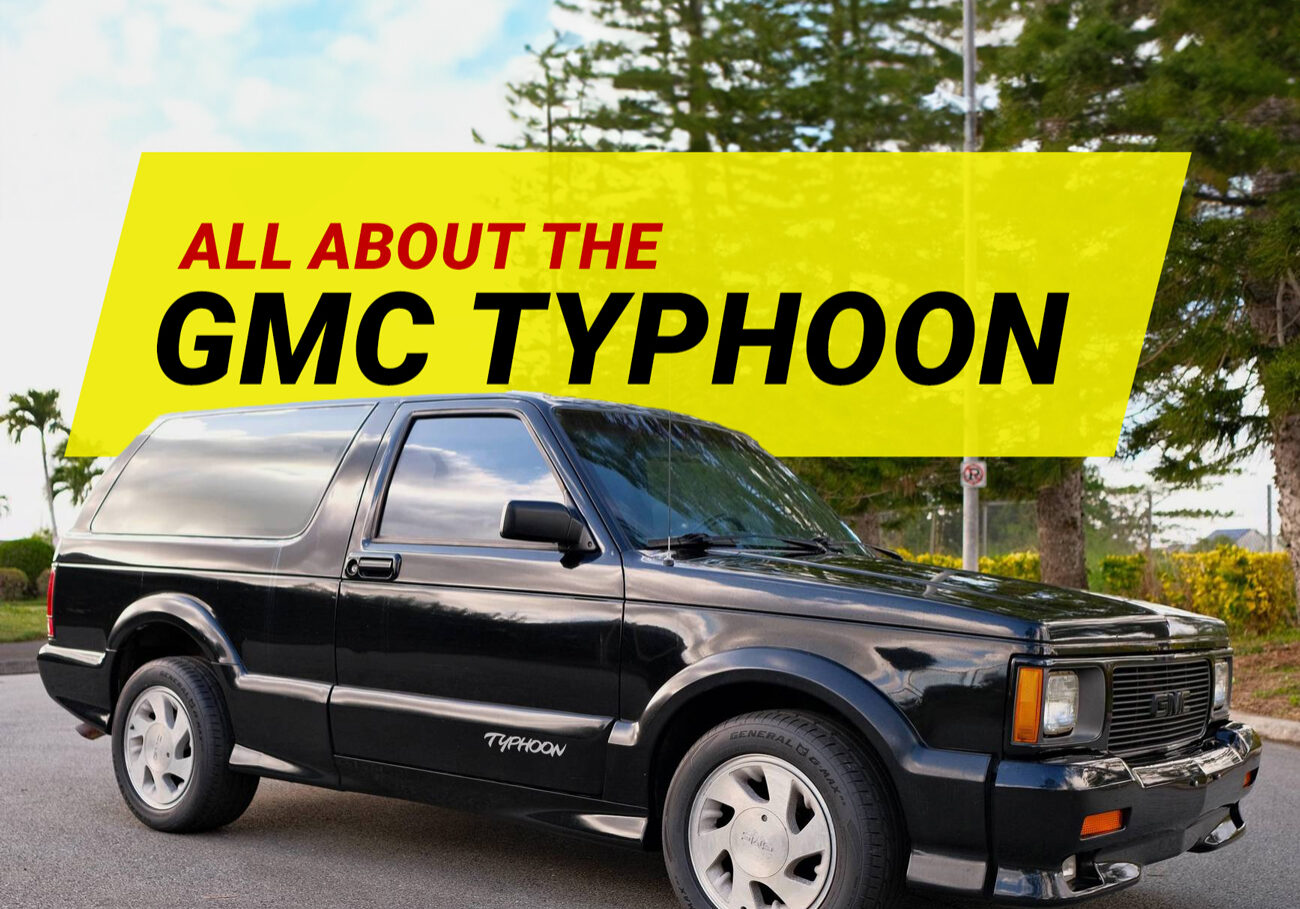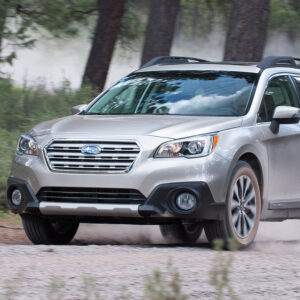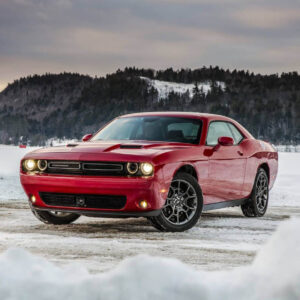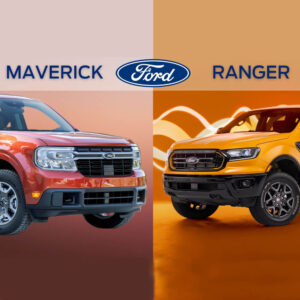The GMC Typhoon: The Performance SUV of The 90’s
The GMC Typhoon is a legendary performance 90's SUV! It wowed enthusiasts with its performance and styling since it was unveiled in '91.
Updated: September 6, 2023 // History

The GMC Typhoon laid the foundation of high-performance SUVs (like the Trackhawk). Produced by Production Automotive Services (PAS) in Troy, Michigan, the Typhoon’s legacy is one of power, speed, and innovation.
The Typhoon’s exterior design stands out from other SUVs. It has an aggressive stance, bold styling, and sleek lines. Inside, there’s a comfy cabin with luxury and practical features. Sport-inspired seats and advanced tech enhance the driving experience.
The GMC Typhoon only had a short production run but made its mark on history. In 1999, Jeremy Clarkson drove a Typhoon during Top Gear filming. He described the incredible acceleration and handling as he pushed the limits of this mighty SUV on a race track.
GM Sensed a Shift in Consumer Focus
As the 1980s transitioned into the 1990s, consumer preferences underwent a significant transformation. Practicality alone was no longer the driving force behind vehicle purchases. Manufacturers, keenly attuned to this shift, began releasing cars designed to cater to the desires of speed enthusiasts. However, not all of these attempts met with success.
Vehicles like the 1989 Shelby Dodge Dakota and the 1990 Chevy 454 SS failed to capture the hearts of performance-seeking buyers. It was against this backdrop of consumer demand that the GMC Typhoon emerged as a game-changer.
Also See: The C10 Truck: From Workhorse to All-purpose Chevy Classic
The Genesis of a Speed Demon Typhoon
The GMC Typhoon can be traced back to its platform-based sibling, the GMC Jimmy. Emerging onto the scene in 1991, the Typhoon took the world by storm with its audacious blend of power and style.
The GMC Typhoon was not your typical SUV; it was a high-performance beast that pushed the boundaries of what was possible in its era. Built upon the chassis of the GMC Jimmy, it featured a modified version of the Vortec engine found in its more conventional counterpart.
At the heart of the Typhoon roared a modified Vortec engine, an engineering marvel that propelled this SUV from 0 to 60 mph in a blistering 5.3 seconds. This astonishing feat catapulted the Typhoon into the league of high-performance vehicles, leaving competitors in its dust.
Related: The 10 Most Popular Dream Cars Today
History of the GMC Typhoon
In 1992, under the leadership of General Manager Roy S. Roberts, GMC’s engineers set their sights on transforming the Jimmy sports utility vehicle into something extraordinary. They transplanted the Syclone‘s mechanical components into the SUV, giving birth to the Typhoon.
While the GMC Syclone was slightly quicker due to its lighter weight, the Typhoon offered a more practical solution, accommodating four passengers. Under the hood, the Typhoon boasted a powerhouse of an engine, equipped with a Mitsubishi TD06-17C/8 cm2 turbocharger, a Garrett Water/Air intercooler, revised intake manifolds, fuel system upgrades, and a 2-inch twin-bore throttle body sourced from the 5.7 L GM Small-Block engine.
Limited Production
The story of the GMC Typhoon begins with its incredibly limited production run. In 1991, only six pre-production models were crafted, setting the stage for what would become an iconic SUV. The commercial release of the Typhoon spanned just two years, from 1992 to 1993, with a total production count of only 4,697 units. Among these, 2,497 rolled off the assembly line in 1992, followed by 2,200 in 1993.
The Typhoon & Syclone Connection
The Typhoon’s story cannot be told without acknowledging its counterpart, the GMC Syclone. In 1991, GMC’s General Manager, Lewis B. Campbell, took the helm and decided to explore the potential of high-performance compact pickups. Buick engineers had initially conceived the idea of placing the Grand National’s 3.8-liter V6 engine in a Chevy S10 chassis, but both Buick and Chevy rejected the proposal.
GMC, however, recognized the opportunity and brought the concept to life. The result was the Syclone, a limited-production version of GMC’s Sonoma. With a 4.3-liter V6 engine and performance that rivaled contemporary sports cars, it was an audacious move. However, public reception remained lukewarm due to perceptions of high pricing and the Syclone’s limited utility as a pickup truck.
Related: GMC Syclone & Typhoon: 15 Mind-Blowing Facts You Didn’t Know
The GMC Typhoon Had a Star-Studded Following
The allure of the GMC Typhoon extended beyond the racetracks and highways. Notable personalities such as Clint Eastwood and JFK Jr. were captivated by its charismatic charm and unrivaled performance. Their ownership of this automotive gem only served to elevate its prestige and desirability.
A fun fact about the GMC Typhoon is that it was prominently featured in the movie “Daylight” (1996), with Sylvester Stallone driving it during the action scenes.
Reception of the Typhoon
The introduction of the GMC Typhoon sent shockwaves through the automotive world. Its advertising boldly compared it to luxury sports cars, declaring, “If you have settled ideas of luxury, safety, and performance, a Typhoon will blow them away.” However, with a starting price of $29,970 (equivalent to approximately $57,333 adjusted for inflation), it faced challenges in gaining widespread acceptance.
Ultimately, the Typhoon’s production lasted only from 1992 to 1993 before its cancellation. This was attributed to its relatively high price, the closure of the company responsible for modifying the S10s, and consumer preferences shifting towards more affordable and sporty options like Mustangs and Camaros.
Moreover, the Typhoon’s lowered height made it unsuitable for off-road use, limiting its practicality for certain consumers who required versatility from their vehicles. Off-road adventures posed a risk to the chassis and drivetrain due to its reduced clearance.
The Typhoon’s Lasting Legacy
The GMC Typhoon’s significance in the automotive world goes beyond its limited production run and high-performance prowess. In 1991, when the first Typhoon rolled off the assembly line, the concept of a high-performance luxury SUV was unheard of. It changed the perception that trucks were solely used for farm work and practical purposes, now they could race for pink slips.
While its time in production was short-lived, the Typhoon paved the way for speedy SUVs years later. It signaled a shift in focus from utility and off-road capability to catering to road-focused enthusiasts.
Check out the Typhoons sales and performance table:
| Year | Sales Figures | Performance | Market Disruption |
|---|---|---|---|
| 1991 | 6 | 0-60mph in 5.3s | Redefined SUV Segment (Typhoon Pre-Production) |
| 1992 | 2,497 | Advanced AWD | Introduction of Turbocharged Engine |
| 1993 | 2,200 | High Top Speed | Pioneered Sporty Design Elements |
Notably, the GMC Typhoon had extraordinary sales figures during its time, showing its popularity with car lovers. Moreover, its acceleration of 0-60mph in 5.3 seconds and advanced AWD system set new standards for SUV performance. Additionally, its turbocharged engine brought more power and excitement to SUVs.
GMC Typhoon Fast Facts
- Most Popular Color: Black/Black, accounting for approximately 48.3% of total Typhoons produced.
- Sales Breakdown: 1,262 units sold in 1992, followed by 1,008 units in 1993.
- Resale Value: Syclones and Typhoons in good condition have fetched prices exceeding $120,000 in the second-hand market.
- Unique Features: Remote keyless entry, electronic level control, 16-inch aluminum wheels with speed-rated tires, recalibrated shock absorbers, and modified suspension.
- Rarest Color Combinations: Radar Blue/Radar Blue and Raspberry Metallic/Raspberry Metallic, with only two units each, accounting for approximately 0.04% of total sales.
Like Trucks: All-New 2024 Ford Maverick Convertible Pickup Truck
The Cult of SyTy
Even today, the GMC Typhoon has a devoted following, with prices for well-maintained units trending upwards. Enthusiasts affectionately refer to themselves as part of the “SyTy” crowd, combining “Sy” from Syclone and “Ty” from Typhoon. Online forums and gatherings like the Carlisle, SyTy Homecoming, and SyTy Nationals showcase the enduring passion for these vehicles.
GMC Typhoon Questions
1: What is the GMC Typhoon?
Answer: The GMC Typhoon was a high-performance SUV produced by General Motors under the GMC brand. It was based on the GMC Jimmy and was introduced in 1991.
2: What made the GMC Typhoon special?
Answer: It was one of the first high-performance SUVs. The GMC Typhoon featured a turbocharged 4.3-liter V6 engine, all-wheel drive, and sporty design elements.
3: How fast was the GMC Typhoon?
Answer: 0 to 60 mph in just 5.3 seconds, making it one of the quickest SUVs of its time.
The GMC Typhoon boasted a powerful turbocharged engine that produced 280 horsepower and 360 lb-ft of torque.
4: How many GMC Typhoons were produced?
Answer: Production of the GMC Typhoon was limited, with a total of 4,697 units built between 1991 and 1993. This rarity adds to its appeal among automotive enthusiasts and collectors.
5: Was the GMC Typhoon a successful model?
Answer: While the GMC Typhoon was not a mainstream success in terms of sales numbers, it gained a cult following and is highly regarded in the automotive world.
6: Is the GMC Typhoon still in production?
Answer: No, the GMC Typhoon was only produced for a limited time from 1991 to 1993. However, there are still GMC Typhoons available in the used car market, and they are sought after by collectors and enthusiasts.
Disclaimer: The writers of this article may have used artificial intelligence to help them with some of the material. It should not be a replacement for professional help.







